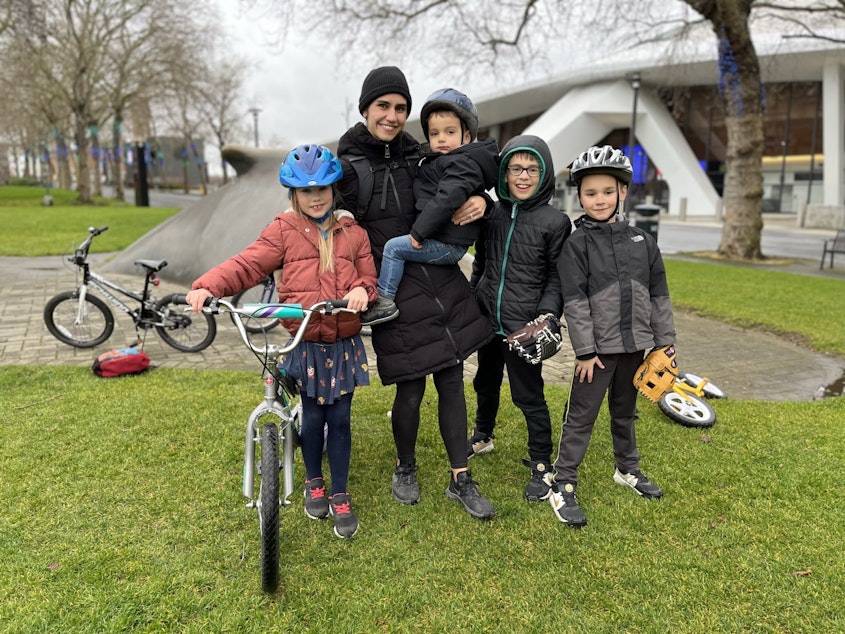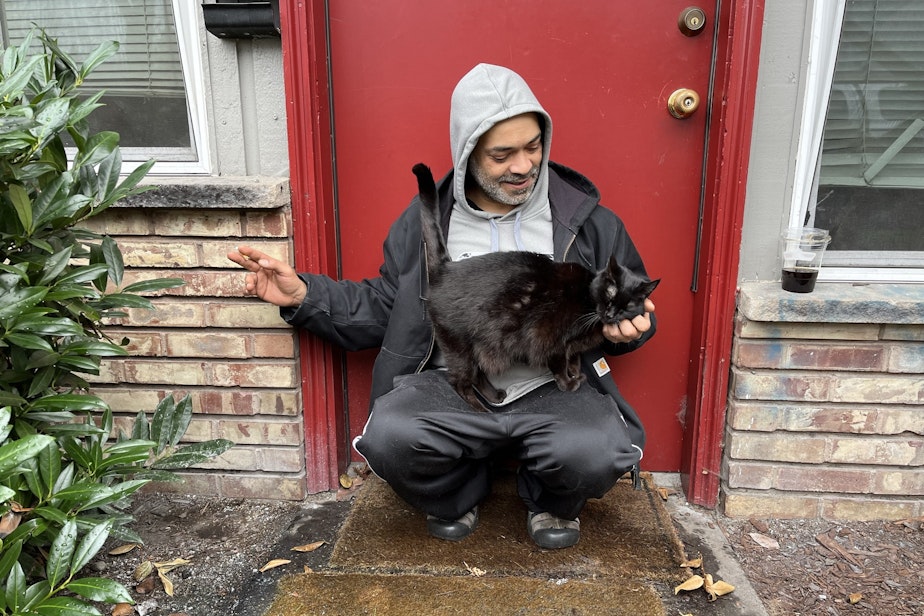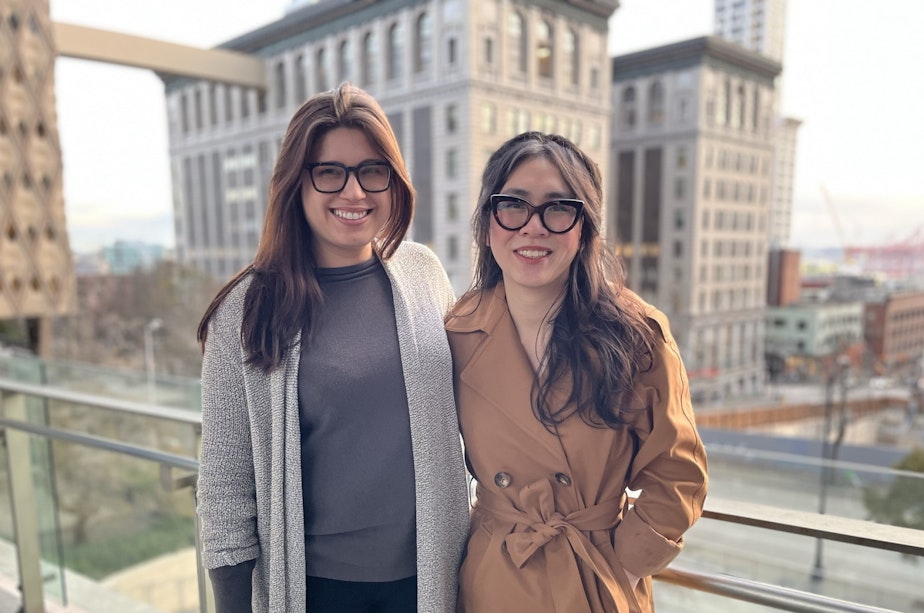What would make you live in downtown Seattle? Residents answer, city listens

One of the big lessons to come out of the pandemic is that downtowns need people; not just office workers — people who live there too.
But how do you get people to move downtown?
That’s a question Seattle city officials are grappling with right now.
In part 3 of our series “Downtown Reimagined,” KUOW’s Joshua McNichols went looking for downtown residents to find out what’s working and what’s not.
C
harissa Lundy has four kids, all under 11 years old. They live in downtown’s Lower Queen Anne neighborhood. In some ways it's tight. But the opportunities are expansive.
"We think of the whole city as our kids’ backyard, " Lundy said.
This past weekend, I found them at Seattle Center fountain, along with a heap of bicycles and baseball gloves they’d brought with them.
“I like how you can go places all over," said 8-year-old Harlow as she explained what she likes about living downtown. "And there’s a children’s museum that’s really fun. That’s why I like it.”
Sponsored
“I love the Children’s Museum too," I said. "What’s your least favorite thing about downtown? Is there anything you don’t like?”
Sponsored
“No, there’s not anything I don’t like,” she said, drawing a laugh from her mom.
“What about not having a yard?” Lundy asked.
“Not really.”
“What about all the trash?” asked Aiden, Harlow's brother.
“Well, I don’t like that.”
Sponsored
Lundy said her family will probably need a bigger apartment soon. But she’s worried they won’t find anything they can afford downtown.
"Basically, to get that extra space, it’s gonna cost $1,500 more a month," she said. "And it feels so hard to get there right now."
This was a recurring theme among the people I spoke with: There aren't enough affordable places for families to live.
The second most common complaint I heard was about public safety.
J
Sponsored
oseph O’Connell has lived in Lower Queen Anne for 18 years.
“You have to be aware of your surroundings. Especially if you're walking around," he said. "I mean, I'm different — a frickin' male — people don't tend to mess with me. And I hate to say this, but if I had the misfortune of having a young daughter or something like that, I'd tell her to stay the hell away from downtown if she's by herself, you know what I mean? There's a lot of people on drugs out here. It's kind of crazy.”

Right now, city staff are doing a lot of listening to residents like these. They’re working on a long-term plan for downtown’s future, called the "downtown sub-area plan." Like the larger, city-wide "comprehensive plan," it's one of the documents that will guide the city's growth and development over the next 20 years.
The pandemic has shown that we need more than just office buildings to keep downtown healthy. We need more people to live there.
Sponsored
So city staff wants to know what kind of spaces or services would draw people to the city’s core. They’re starting the process with a fundamental question: Who is downtown for?
“Who gets to ask that?" said Amy Nguyen with Seattle's Office of Planning and Community Development. Nguyen is one of the staffers working on the plan for downtown's future.
"Who gets to build that roadmap? A lot of how we are approaching this planning process is really centering that equity and engagement, so we can expand that scope,” she said.

“A plan that I like to talk [about], that I’m excited about, is what came out of New York City in December of 2022, the 'New New York Plan,'” Nguyen added.
Sponsored
Under its new mayor, New York City is re-imagining the future of its downtown by centering its immigrants and refugees — people who helped build New York City, but can’t afford to live there today.
“Now, we in Seattle have that same rich story. When we think about downtown: Who built downtown? I think it’s very easy to get stuck in a very traditional [narrative] – especially in the last decade, of a tech-dominant [economy]…but we have so many rich threads of what built this economy, too.”
The comments the city has heard so far (before the process formally begins) are revealing that it’s more than just affordable housing and public safety that people need downtown. People need schools, mental health services, affordable food, and tiny retail spaces where it doesn’t cost a lot to set up a business.
Overreliance on big employers made Seattle vulnerable when remote work took downtown's office workers away. But last week, Amazon announced it will require workers to come to the office three days out of the work week.
It could be seen as tempting to return to the way Seattleites worked downtown before Covid. But at best, Seattle would never achieve more than three-fifths of its old vitality, if nothing else about downtown changes. Getting downtown's pre-pandemic energy back would require more people working — or living — in the area.
In his State of the City speech Tuesday, Seattle Mayor Bruce Harrell said that while he celebrates Amazon's return to the office, downtown still needs to diversify.
"It’s the time for bold action," Harrell said. "It may mean changing our zoning codes to convert excess, unused office space into housing. It may mean allowing greater flexibility in the use of street-level building spaces...In fact, in March, our city planners will launch a design competition around converting office buildings to housing. We need to recognize that downtown’s office spaces may never fill up as before, and we need more housing options. Let’s make downtown affordable for everyone who wants to live there."
RELATED: From offices to apartments and back — Could transformable buildings help revive downtowns?
In Lower Queen Anne, Joseph O’Connell is skeptical.
“You can have all the plans you want. But, I don’t know. If the last 10 years have taught me anything, it’s that plans don’t mean shit. You’ve got to deal with the real problems first.”
O’Connell won’t be around to see what happens though. His apartment building of 18 years is scheduled to be torn down soon, and replaced with townhomes.
He’s planning to move to Ballard.
This story is part of a KUOW series called "Downtown Reimagined."


